Join photographer and writer Dev Raj Agarwal on assignment as he travels down the Ganga River from Haridwar to Varanasi, along the way documenting the temples, river ghats, religious fairs and local histories. Be part of the bank-side daily worship of ordinary Hindus as well as the special rituals—from the first head-shaving of young children to wedding blessings, final cremation rites and offerings to ancestors.
By Dev Raj Agarwal, Dehradun
Many times when i was young my mother took me to Haridwar, just 30 miles from my home, to take a dip in the holy Ganga at Har Ki Pauri ghat. Later in my life, I visited Varanasi several times; but except for Prayag, everything between Haridwar and Varanasi was just names on a map to me—until I proposed to Hinduism Today we explore that 600-mile stretch of the holy river. That proposal resulted in a fascinating week-long journey starting February 20, 2021.

Day 1: Haridwar to Shukratal
In the old days, such a grand journey would have poetically begun with a footstep. Today, it’s a four-hour drive along narrow, dusty roads through small villages and fields along the river. Finally, we reach the first significant pilgrimage center downstream from Haridwar: the ancient town of Shukratal (recently renamed Shukatirtha). Located on a low mound just off the Delhi-Haridwar highway, this small town with its conglomeration of temples and ashrams is a favorite place for pilgrims and tourists alike. The river ghats here are small and beautiful. Technically, the ghats are on a small tributary river, Budhi Ganga, with Ganga itself a bit to the east, but all who come here regard these ghats with equal reverence.
An intricate web of mythological stories and beliefs encompasses this place. It is said Abhimanyu’s son, King Parikshit of Hastinapur, spent the last seven days of his life here listening to a recitation of the Bhagavatam by Sage Shukdev under a banyan tree. A huge banyan here on the grounds of the Shukdev Ashram, said to be that same tree, is still used for discourses by prominent saints of the area. The sprawling ashram property has many temples, including one for Shukdev, rooms for pilgrims and a large cow shelter.
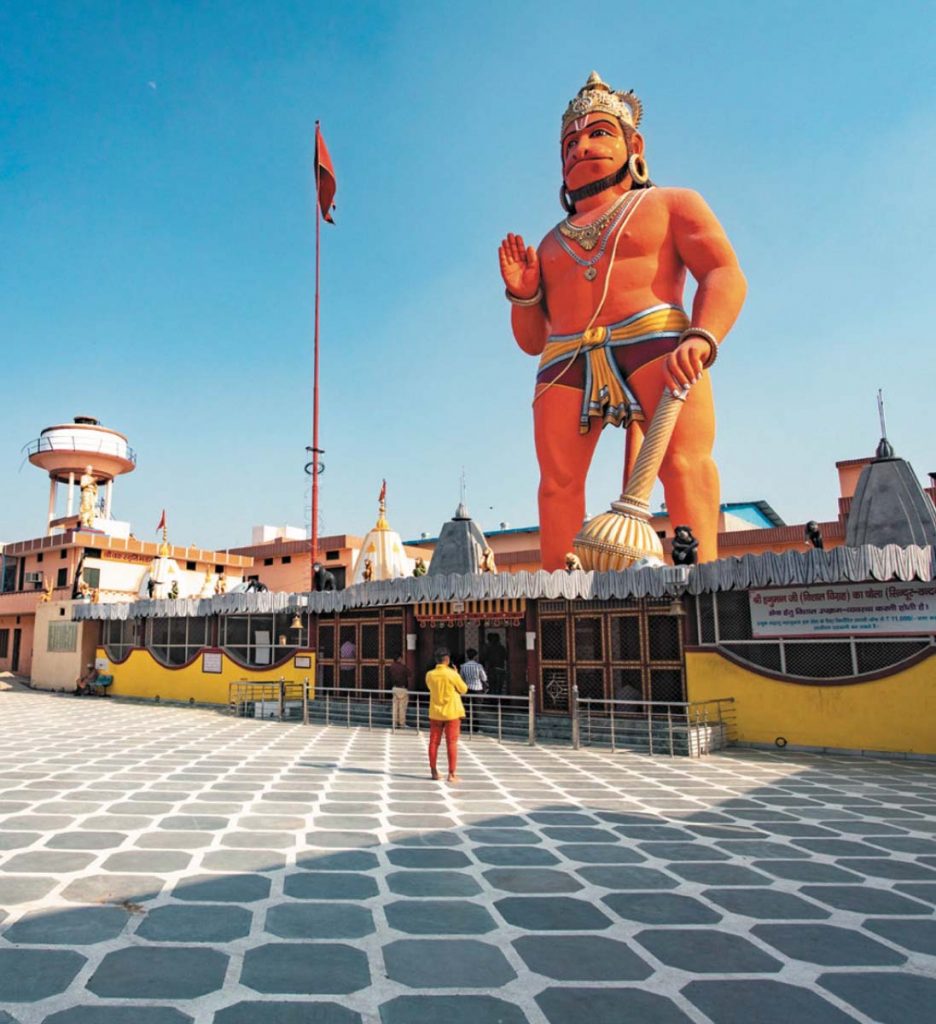
In the courtyard of the Hanuman Dham Ashram stands a 77-foot-tall statue of Lord Hanuman. Like Shukdev Ashram, Hanuman Dham has (or is building) many facilities—library, Sanskrit institute, old age home, free pilgrims’ hostel, free food facilities and more.
Here I am able to speak with Swami Keshav-
anand Saraswati, who explains the strong connection of this place with accounts in the Mahabharata. He tells me that some of the temples in the area are as old as 1,000 years. He appreciates the government’s efforts to clean the river. “The Herculean task of cleaning Ma Ganga will be easier to finish if it becomes a movement of the people and not the duty of a handful of people,” he tells me.
A few of the other prominent ashrams here are Ganesh Dham, Shri Ram Ashram, Shiv Dam and Durga Dham. For pilgrims whose only goal is a bath in holy water, Shukratal is a better option than Haridwar. It is quieter, cleaner, cheaper and more confortable than among the bustling crowds of Haridwar.

I am told of a temple and ashram across the river in Bijnor district dedicated to Vidura, a central figure in the Mahabharata. He was the prime minister of the Kuru kingdom and a close ally of the Pandavas.
I visit the Vidura Kuti, as it is called, in the evening. It was built by the Birla family and opened in 1960. While there, I meet Daal Chand, a simple villager from Naugama in Bijnor, who has come to the banks of the river to immerse the ashes of a relative. “We have Ganga close to home, why go elsewhere for rituals and bathing?” He tells me thousands of people throng to the sandy banks on full and new moon days. I stay the night, returning the next morning to the right side of the river on a narrow road through heavy fog.
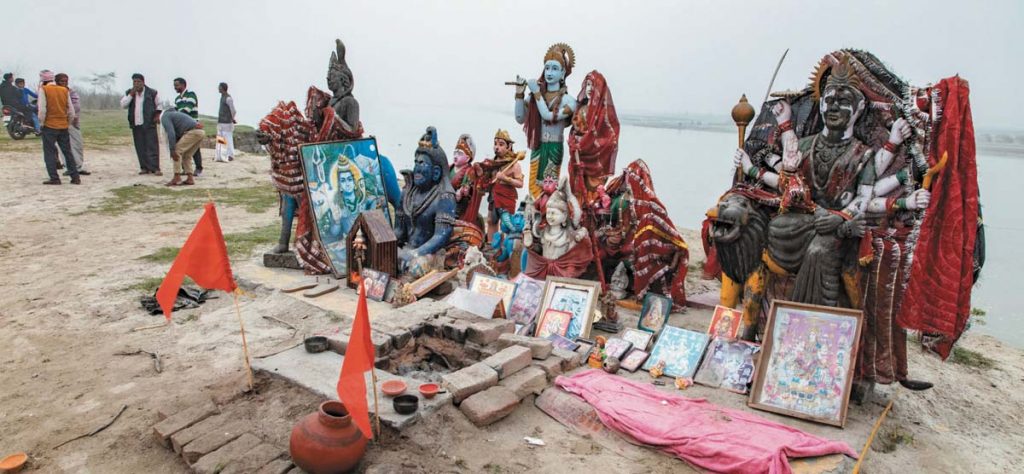
Day 2: Shukratal to Hastinapur
Situated in ravines adjacent to the Ganga, Hastinapur was once the capital of the Kauravas. Today it is just a small town, with a population barely over 20,000, but its temples and ancient ruins testify to a rich cultural past. The town figures prominently in events of the epic Mahabharata. The one hundred Kaurava brothers were born here to their mother Gandhari, wife of King Dhritarashtra.
The most prominent temple here is the Pandeshwar Mahadev temple, which was extensively renovated in 1798 by Raja Nain Singh of Bahishuma Fort, Parikshitgarh. It is surrounded by high walls, with dome-shaped pavilions called chatri in the corners of the walls. A huge banyan tree faces the façade. The Lingam inside the sanctum sanctorum is believed to be from the times of the epic. Ruins of old forts made with thick walls of mud and brick can be seen on Pandav Teela, a tree-covered hillock to the right of the temple. One also sees a few caves, perhaps used for meditation by saints and sages.
In 1945, excavation of a nearby site uncovered a stone panel with five figures, badly deteriorated with age. At the suggestion of Pandit Jawaharlal Nehru, this was installed in the temple, where it can be seen on the wall near the Lingam [see photo below]. The temple’s head priest has said the five figures are the Pandavas, but a definitive determination is impossible.
Swami Shankar Dev of Karna temple tells us that in the government’s official revenue records, the area of the temple is still called Kaurvan, “the area of Kauravas,” and the other part of the town is called Pandavan—“the area of Pandavas.” As recounted in the Mahabharata, the town was completely destroyed after Duryodhana was killed.
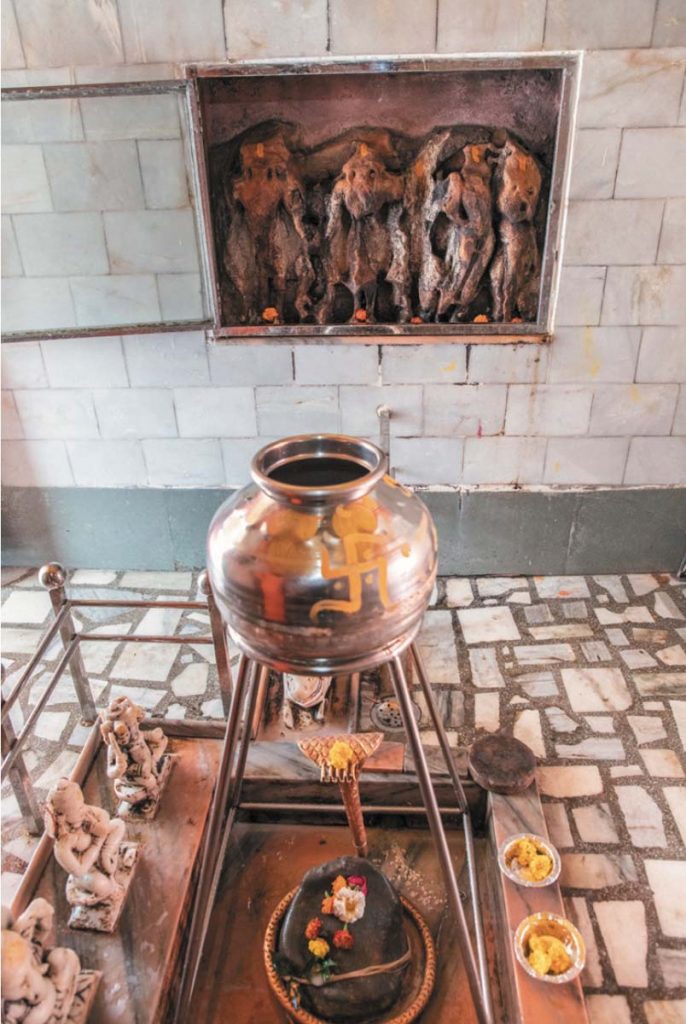
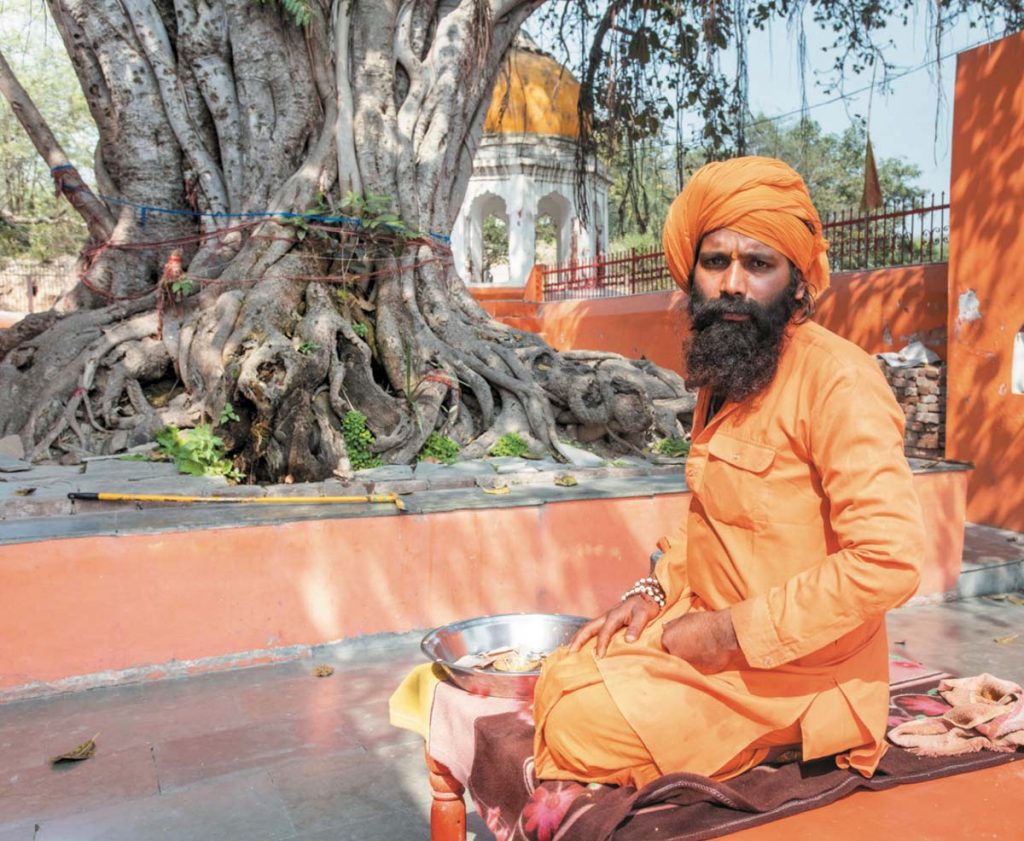
Departing this area, our road is occasionally blocked by tractors pulling trailers carrying huge loads of sugar cane. But the sweet smell of boiling sugarcane is sufficient recompense for any inconvenience. Along with wheat and rice, sugarcane is a main crop in this fertile and prosperous area of the Gangetic plain. Much of the day is spent on these small roads, which lack restaurants, petrol stations and restrooms. Here the cities, towns and major roads have been established at a safe distance from the river, which can change course easily and unpredictably in a single season.
Finally, we reach Garhmukteshwar, the first actual city near the river after Haridwar. Once part of the kingdom of Hastinapur, Garh (as it is popularly called) is full of good hotels, petrol stations and amenities. Major east-west and north-south highways pass through, bringing hundreds of thousands of devotees from Haryana, Delhi (just 70 miles away), Rajasthan and nearby places. The high point of the year is the Ganga Snan Mela on Kartik Purnima in November, but this was canceled in 2020 on account of Covid-19. Ordinarily, the Mela caters to the Delhiites with a show of luxury and extravaganza, including air-conditioned tents and all modern facilities.
In the evening I visit Brijghat, three miles east of Gahr proper. The neighborhood is clustered with temples and ghats—like Varanasi, but on a very small scale. Brijghat has special significance for performing the pindaan offering to one’s ancestors, as in Haridwar. Walls of the ghat are painted with slogans to keep the Ganga clean, which to me seems a successful mission by the government. Late in the evening, after a boat ride, I visit Vedant Mandir, one of the many ashrams and temples along the river. I then return to Gahr for the night.
Day 3: Garh to Kasganj
This morning I head for the imposing temple of Mukteshwar Mahadeva in Nakka Kuan, a complex located in Gahr. An Urdu inscription on the structure explains it was constructed by Raja Kishan Chand of Peshawar in the year 1836. It enshrines a Sivalingam along with murtis of Mahishasuramardini, a form of Goddess Durga, as well as Bhairava, a form of Siva. Pilgrims come here in large numbers during their visit for the Ganga Snan Mela.
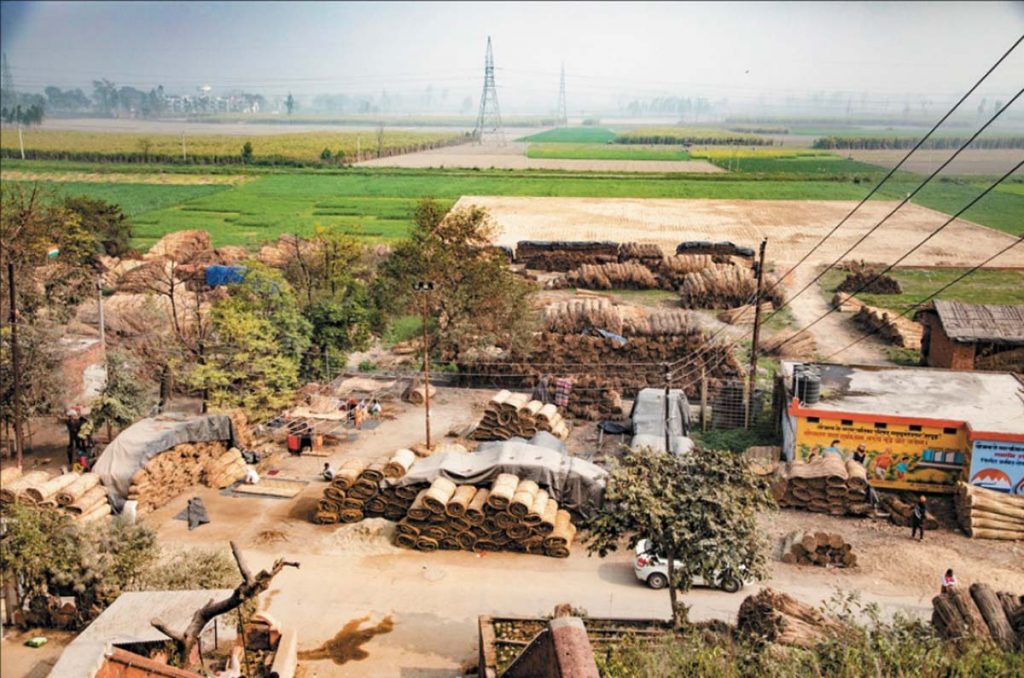
Unfortunately, only a few temples in the Nakka Kuan area remain in good condition. In India, only the most important ancient temples come under the oversight of the Archeological Survey of India (ASI); these are generally well cared for. The rest, falling under the particular state’s often overwhelmed and underfunded archeological survey or temple management division, are less well maintained. For example, the Tamil Nadu State Hindu Religious and Charitable Endowments Department is responsible for 36,425 temples and 56 monasteries!
A few hundred yards from Nakka Kuan is a small hillock, the only elevated feature in the area. Perched at the top, overlooking the vast Gangetic plains, is the Ganga Temple, which has an imposing murti of the Goddess as well as other Deities. One reaches it by climbing a flight of 84 steps. Temple lore has it that the stairs were originally 104 in number and reached the Ganga itself, which originally flowed nearby but is now three miles away. I tend to doubt it had ever passed by this area.
At the bottom of the stairs I encounter a temple devotee named Padam, who sells earthen pots from his tricycle. He has stopped here to worship as part of his daily routine. “This temple is a divine wonder, the house of a living Goddess. Whatever I am, is because of Ganga,” he avers, impressing me with his devotion.
Adjacent to the Ganga Temple on the hillock, but now hidden by recent construction, is the Ram Darbar Temple with a black murti of Lord Rama. This temple is in very bad shape but was obviously once quite beautiful.
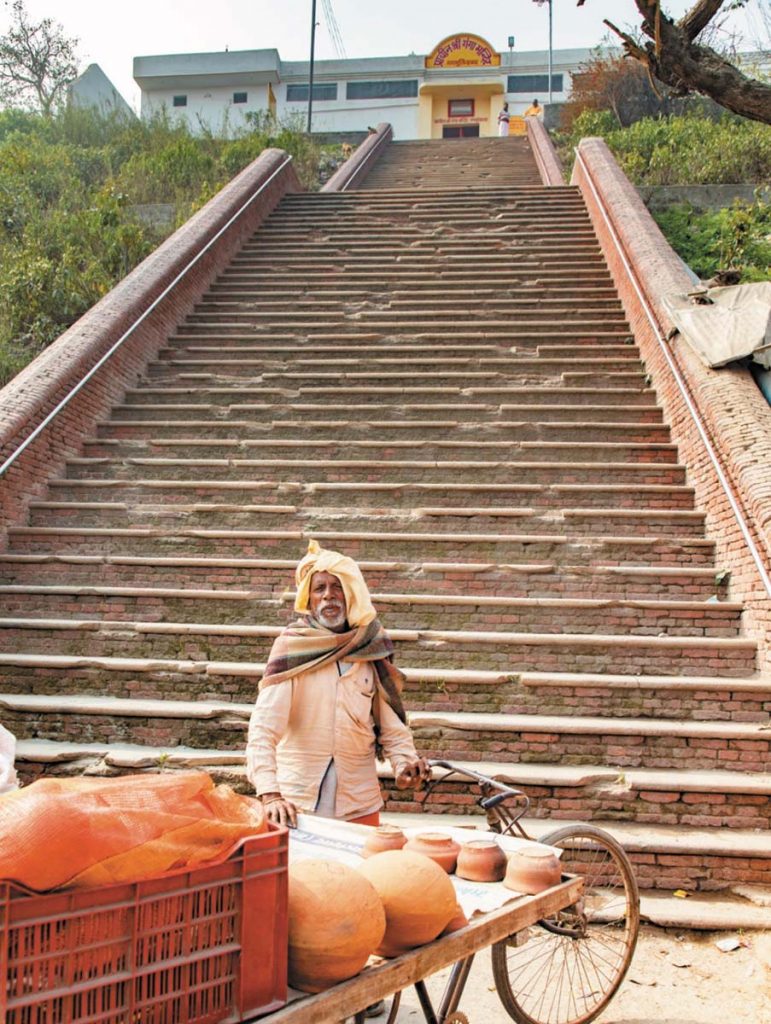
Near the foot of the hillock is a large settlement of families who make mats from a tall reed that grows along the river. Their multifarious weaving activities catch my photographer’s eye. A local weaver named Vijay tells me there are about a hundred weaver families in this neighborhood, and weaving has been done here for generations. They make mats, sitting stools and other small articles from the same reed. Local authorities buy the mats at us $0.50 in large quantities to use in place of plastic ground sheets for the hundreds of tents pitched during the Ganga Snan Mela.
“The marshes are declining, as more land is transformed into cultivation,” Vijay tells me. “We are now forced to get the reeds from as far as Bijnor.”
Leaving the weavers, I proceed several miles downstream to Aupshahar, a rough, three-hour trip on a pot-holed road. Located here is the sprawling Mast Ram Ghat, recently constructed by an industrial house. This could well be the longest, cleanest and most beautiful recently built ghat on the entire river.
Nine miles from Aupshahar is Karnavas, a rustic village just downstream from the river’s confluence with its first left-bank tributary, the Ramganga. This neat, clean place is the site of the beautiful Kalyani Devi Temple, believed to date back to the Mahabharata era. Devotees come in large numbers despite the absence of public transport. Before coming to the temple, they take a dip in the river, 200 yards away. The temple has a delightful door with artwork in brass.
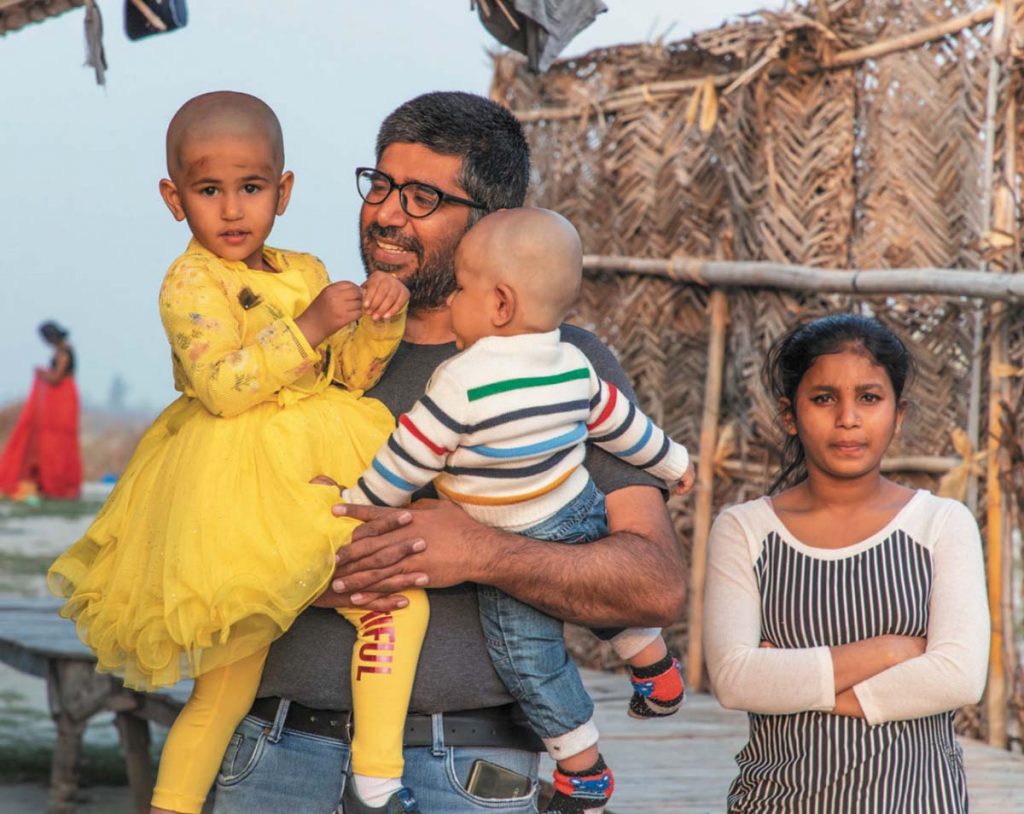
I encounter Jeet Singh Soni at the temple. He has brought his wife, recently-married son and daughter-in-law to seek the blessings of the Goddess for the wedding, which took place last year under Covid-19 lockdown. For people like Jeet Singh, pilgrimage has changed with the times. Now, they arrive by cars on good highways, perform rituals and reach home by night the same day.
Other prominent nearby temples include Bhagwati, Shetala Mata and Karna. About half a mile away is the ancient Bhuteshwar Temple and a Hanuman temple. Along the river is the beautiful Pakka Ghat with an adjacent dharmasala which can house many devotees during festivals.
Karnavas has some extraordinarily beautiful houses, with amazing artwork. These homes flank both sides of the narrow street reaching the ghat. Unlike dismal sights we will shortly encounter as we head south, these show no signs of abuse at the hands of invaders.

Karnavas has always been a center of learning, according to Dr. Baikunth Nath Sharma, the principal of Acharya Ramesh Guruji Ved Vidhya Sansthanam, a school in Vedic studies. This is one of a hundred schools, including two more in Karnavas, established by the Sandipani Rashtriya Vedvidya Pratishthan of Ujjain. Sharma states that, in addition to their study of Vedas, the students are taught all subjects of the state’s education department. “Many students from here are teachers of Vedic studies now. Interest of people across the globe is increasing in Vedic studies, and our students have great job prospects.”
Four miles downstream is Rajghat, a popular bathing ghat especially during the full and new moons. There are no concrete ghats, but there is a bridge. I’ve noticed ghats close to bridges are more popular, as people from both sides can come. We spend the night at Kasganj and proceed to Farrukhabad the next morning.
Day 4: Farrukhabad to Kannauj
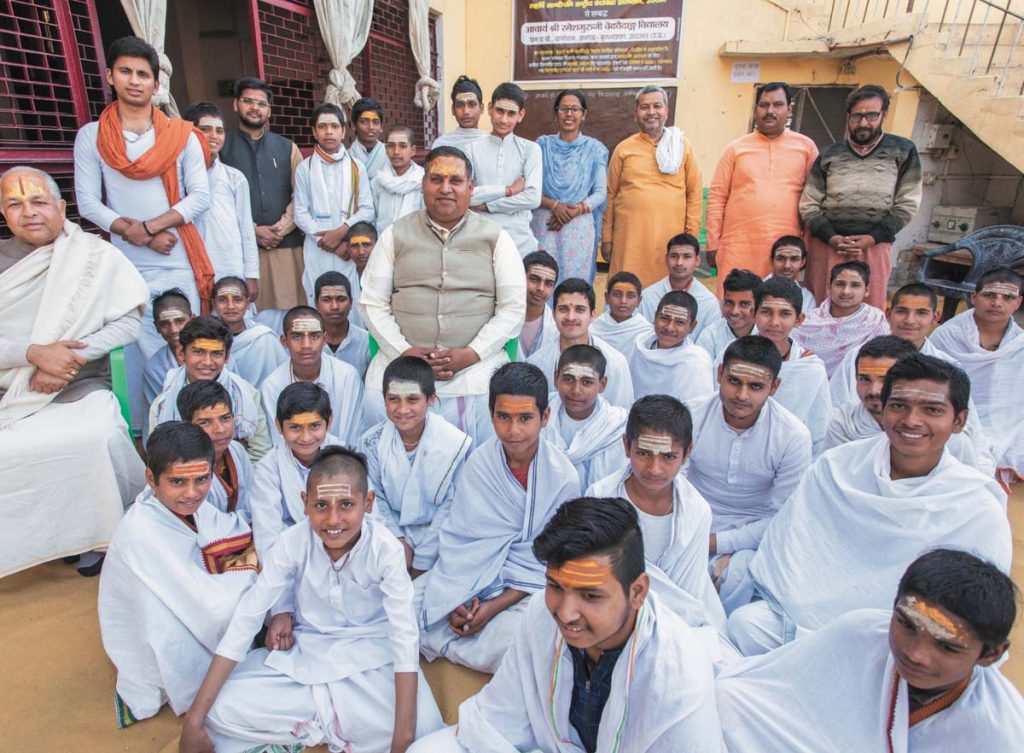
Heading downstream, the changing topography favors potatoes over sugar cane. It is harvest time, and farming families are busy in their fields. We’ve come to the area just in time for the month-long Ramnagaria Mela, with thousands of devotees in attendance. Many are there for a bath, a boat ride and some fun, a few for more serious worship and sadhana. A similar fair, the Magh Mela, is held in Prayagraj at this time, January 27 to February 27.
During the Mela, devotees make a unique offering by draping Ma Ganga in a sari. One such group comprises more than 30 men, women and children gathered on the ghat. They look super excited and lost in themselves, so joyous in their celebration. Priest, boatmen and even a band have been assembled for the ritual. I watch in awe, having never seen this ceremony before.
Some eight to ten saris, each five or six yards long, have been sewn to each other end to end. One boatman stands on the river bank, firmly holding one end of the saris. Everyone else, including the band, sets out in the boats. The roll of saris is held by the family and unrolled by some of the boys as the boats slowly cross the river. Youth and elders alike dance to the tune of Ganga Arati in the boats.
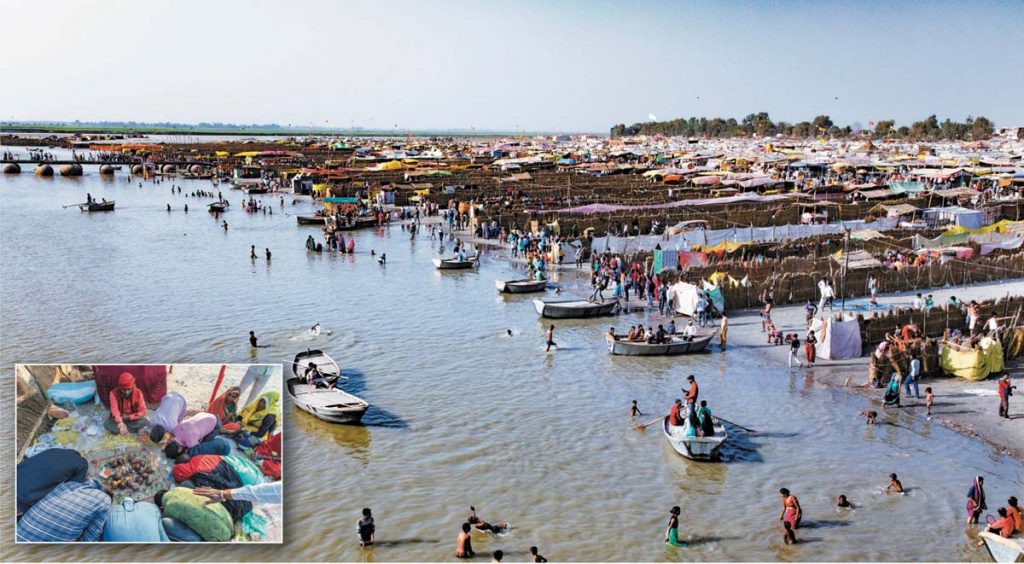
When they reach the other side, the length of flamboyant red saris swings across the whole width of the river, as if playing in the holy water. Those on the far bank loudly hail “Ma Ganga” and roll back the heavy, wet bulk of saris. Everyone comes back across the river, loudly praising Ganga and the family gives the saris to the priest. They all dance again in a frenzy for 30 minutes, then depart.
This ceremony is called pehran, Hindi for “draping.” One member of the group, Praveen Kumar Bajpayee, tells me it is performed at the Magh Mela and Ganga Snan in thanks to the river for granting the family’s wishes.
Hundreds of rows of large tents have been set up for the devotees called Kalpavasis. These spacious tents have a kitchen, washroom and room for a family of five. A stay here is a period of abstinence for these devotees, a time for discipline of body and mind, self-assessment and correction. They eat sattvic food, meditate, attend religious discourses and perform rituals on the river. Sanjeev Pandit, the local priest who performed the sari ceremony, stays in one of these tents, undergoing the disciplines of a Kalpavasi and performing the duties of a priest.
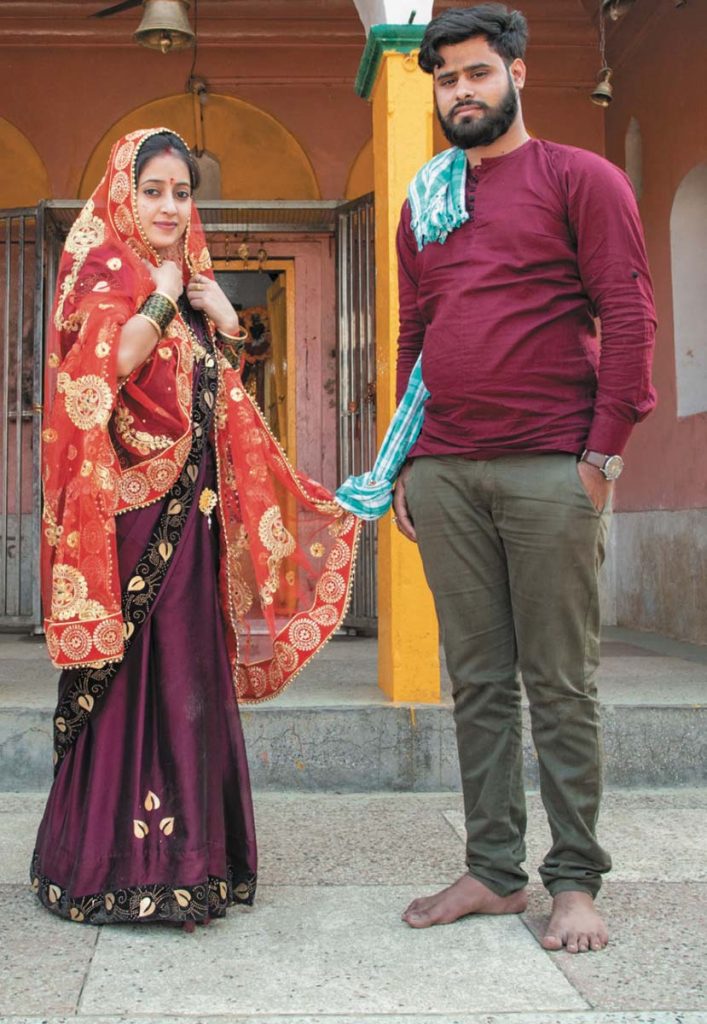
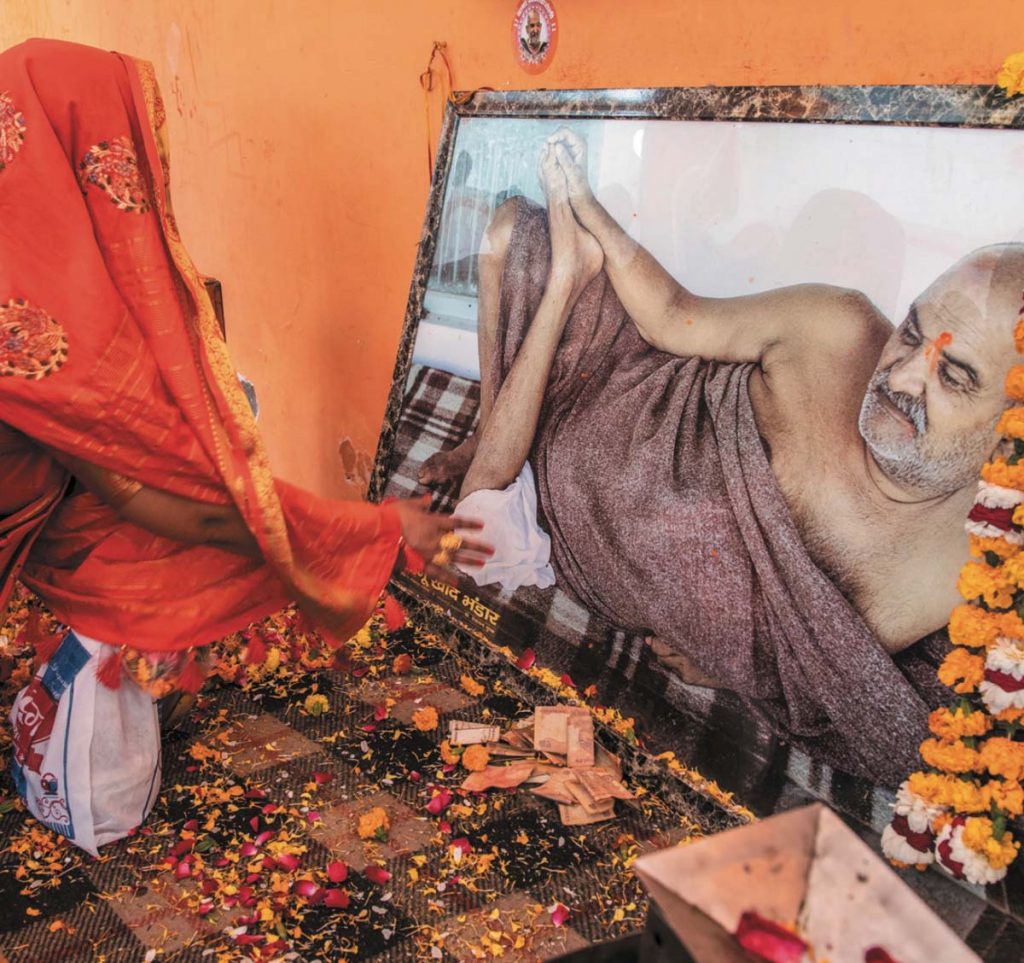
Many Hindus coming here for the mela also visit the Neem Karoli Baba Ashram in Neem Karoli village, 15 miles outside the city, where Baba’s famed “train incident” occurred and after which he took the village’s name. He stayed here performing sadhana from 1912 to 1935. The ashram is buzzing with activity when I visit, with thousands awaiting their turn to have darshan of the statue of Baba in the temple. The ashram priest, Bhanu Ji Maharaj, narrates the famous train story to me. In brief, Baba was traveling through the area by train and had seated himself in first class. Finding that Baba had no ticket, the conductor stopped the train and ordered him off. Baba complied, but then the engineers could not restart the train. Even another engine brought in could not move it. A local magistrate who knew Baba suggested they invite the sadhu back on the train. Baba consented, but on two conditions: that the railroad department build a station at Karoli (none was nearby for miles) and that they treat sadhus better. The train officials agreed, Baba reboarded, and the train started.
After we leave the ashram, a short trip on good roads takes us to Kannauj, where we spend the night.
Day 5: Shivrajpur to Prayagraj
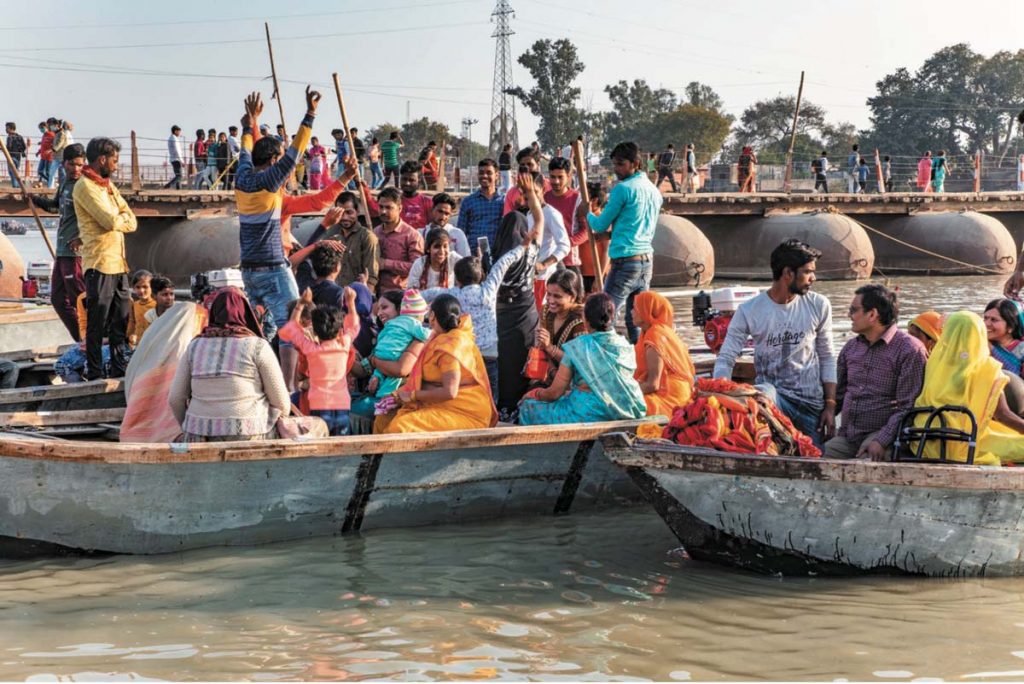
Kannauj is an ancient city located on major trade routes. It has figured in Indian history for three millennia. Here one notices a change in the design of Hindu temples. Several here are taller, slimmer and more ornately embellished, such as Anandeshwar Temple along the main road. The main bathing ghat here is Mehndi Ghat, which is best seen from the Kannauj-Hardoi highway just next to it.
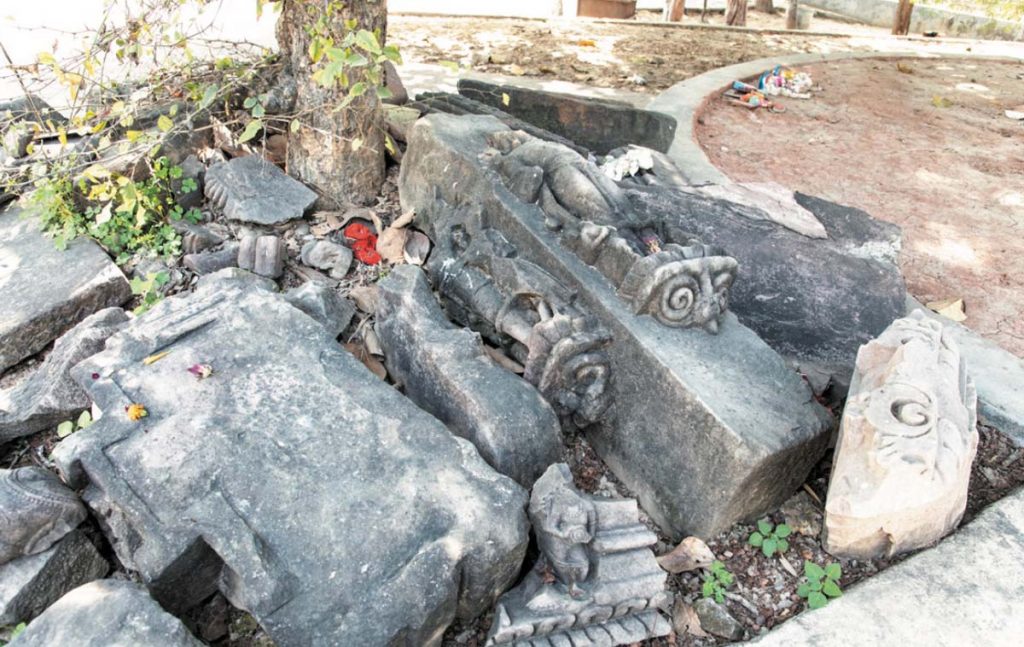
Our main interest in this area is not Kannauj, but the small village of Shivrajpur about 24 miles downstream on the Aligarh-Kanpur highway. The Khereshwar Temple here is a highly revered Siva temple of this region’s more ornate style. The main Lingam of this imposing temple was damaged by Muslim invaders. The temple priest, Akashpuri Goswami, said, “Aurangzeb followed the Grand Trunk Road and plundered temples everywhere in easy access, with Khereshwar no exception.” Lying on the ground behind the temple are broken pieces of intricately chiseled stones from medieval temples, evidence of major destruction. Scores of broken and defaced statues and portions of temples lie unattended in the courtyard, brought here as they are discovered in the area; long slabs of stone and baked bricks come to surface when farmers cultivate their fields. Noticeable color variation in these statues indicates that probably there was more than one temple in the vicinity. A local priest, Anil Shukla, tells me King Sati Prasad built two temples, one for Siva and one for Shakti, at the north end of the ghats with very fine quality brick in 1443ce. It seems Khereshwar had some beautiful Hindu temples prior to the Muslim invasions, replaced since then by the present temples.
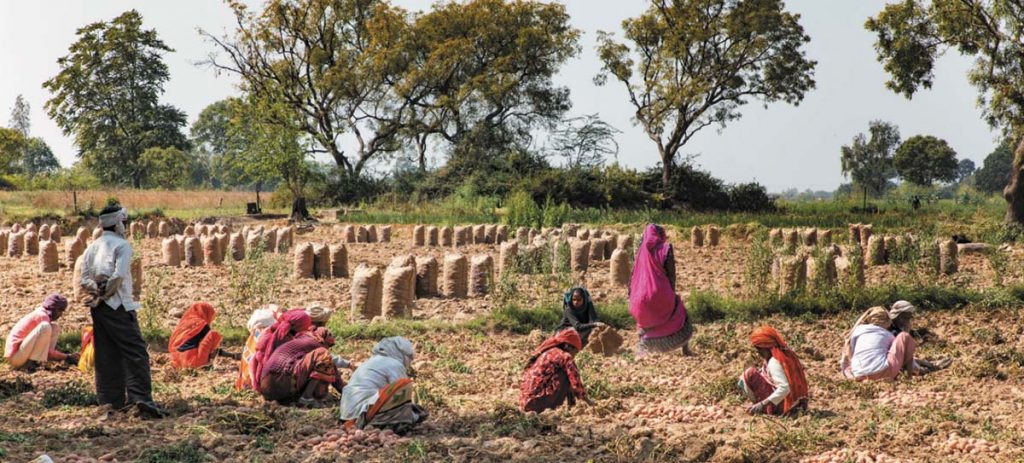
Nearby temples today include the Ashwathama and Dudheshwar temples. In the courtyard of Dudheswar is a small shrine for Baba Mast Ram, who is believed to have initiated many of the temples.
The Ganga runs close by the temples. The beautiful Khereshwar Ghat was built under the patronage of local kings and wealthy families. The river does not seem to have moved away or intruded upon the ghats during the last few hundred years.
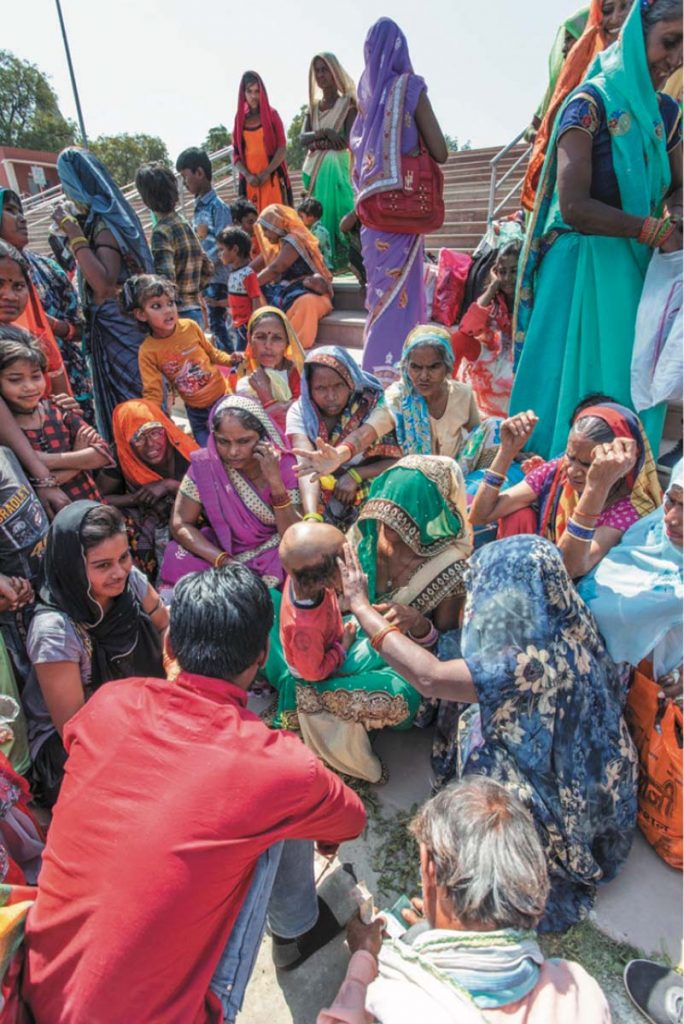
Walking down the riverbank toward the ghat, I realize Ganga is our companion throughout our lives. Cremations are taking place on nearby Kaharraya Ghat. Here on Khereshwar, a newly wed couple, Vikas and Manju, are thanking Goddess Ganga by immersing themselves the river. Nearby, a group of men, women and children are happily gathered around a barber shaving the head of a little boy, a Hindu rite of passage or samskara. They offer the hair to the river with folded hands and enjoy some prasadam. Later I see them all seated on the floor of a giant trailer pulled by a tractor, chanting Ganga’s name as they leave Shivarajpur after a happy day-long outing. How beautifully our social/religious goals are pursued with a pinch of leisure and entertainment!
Downstream of Khereshwar Ghat, Chandel kings built beautiful ghats and pilgrim facilities in the 15th century. There are spacious changing rooms along the ghats and overnight facilities further from the river. Unfortunately, all this is lying in a state of neglect.
A few miles before Kanpur is Bithoor, an ancient city which paid a very high price for its key role in India’s independence struggle, particularly the 1857 rebellion. Bithoor was home to some of the most prominent rebels, including the Queen of Jhansi, Lakshmi Bai. In July 1857, in retaliation for the killing of 300 British men, women and children at Cawnpore, British troops looted and laid waste to the town and killed 25,000 Bithoor men, women and children, leaving many hanging from trees to rot. Nowhere else in the world, it is said, had so many people died at once in the attempt to gain freedom from British rule.
Much further back in history, Bithoor was the site of the ashram of Valmiki, who offered shelter to Sita after she was abandoned by Ram and where their children, Ram and Kush, were born. It is here Valmiki composed the Ramayana.
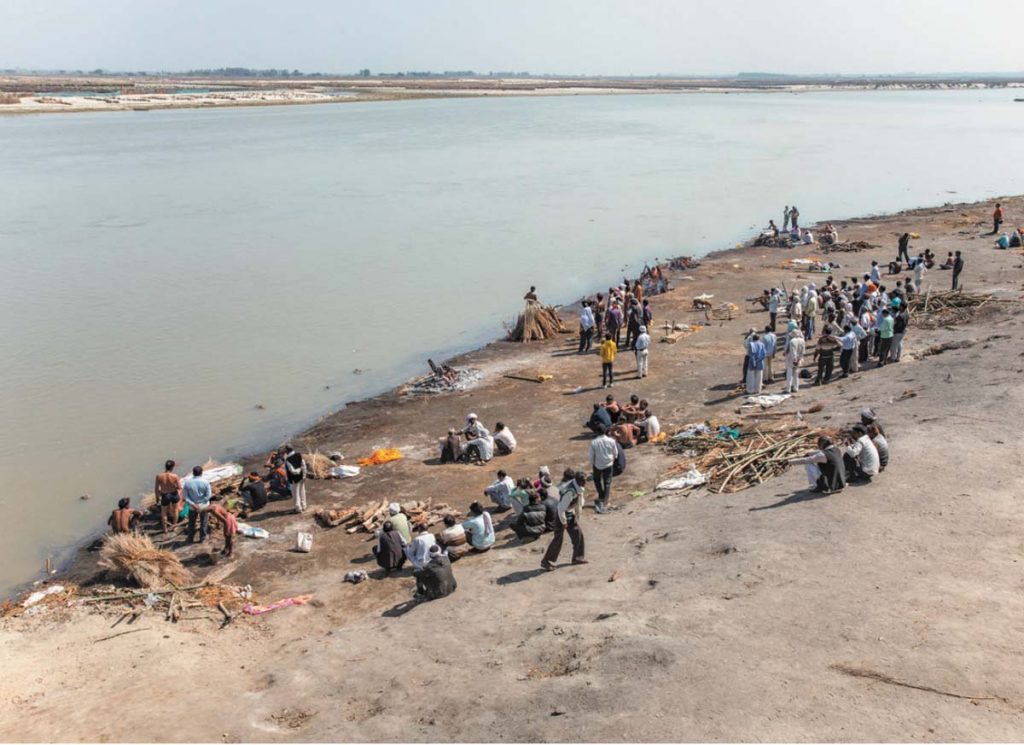

For those living downstream in Kanpur city, Bithoor is the preferred place to worship the Ganga. It is clean and quiet, with the river flowing past long rows of ghats, the most sacred of which is Brahmavart Ghat. Another popular ghat is Patthar, built of red sandstone in the early 19th century by Tikait Rai, a local ruler. The Mahakaleshwar Temple above the ghat, built of the same sandstone, has a giant trident of Siva in the courtyard. Today this temple is under the supervision of the ASI.
In the evening, we drive 15 miles to the city of Kanpur, once noted for polluting the river with effluents from its numerous tanneries. That pollution has been significantly curtailed in recent times, but we decide to continue another 130 miles to Prayagraj (formerly Allahabad) for the night.
Day 6: Prayagraj to Varanasi
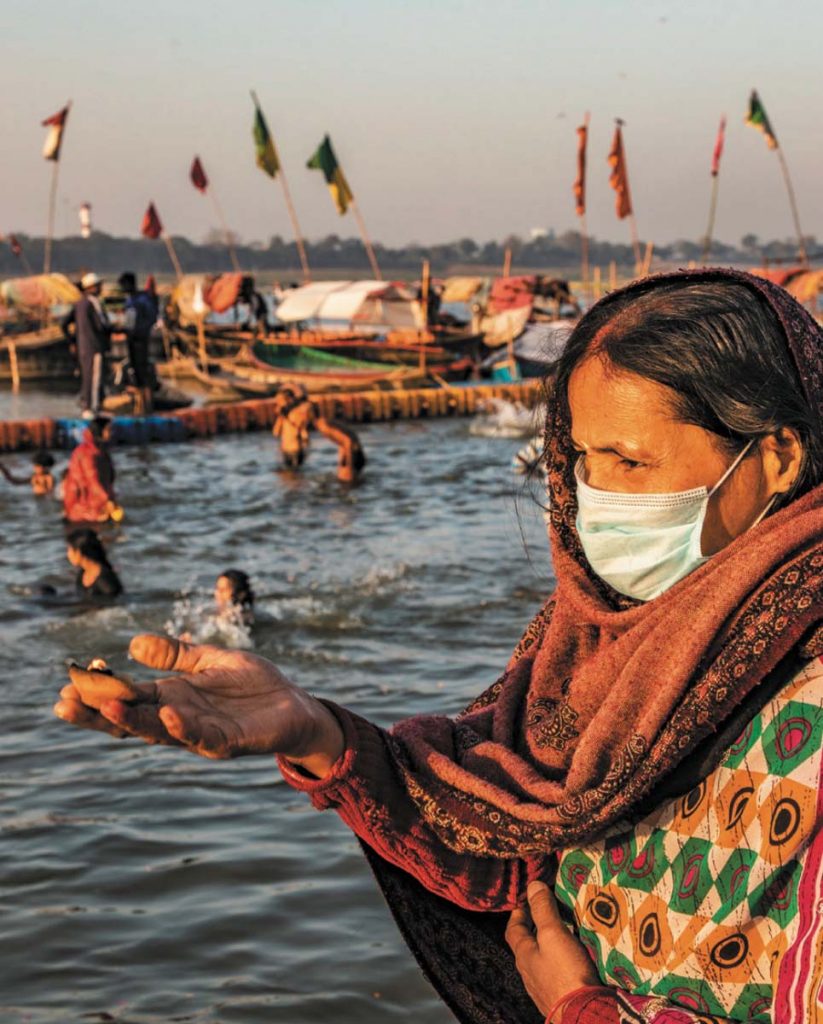
Prayagraj has been covered extensively in earlier issues of Hinduism Today, so we spend little time here. This is the month of the Magh Mela, so normally the area would be flooded with hundreds of thousands of worshipers and Kalpavasis. But due to Covid-19, there are few devotees, and practically no sadhus. The early-morning rush of people on the ghats is as usual, but these are all local people coming for their daily rituals. After a morning here, we head on to Varanasi. Though it, also, has been covered many times in the past, I hope to arrive in time to photograph the evening Ganga arati worship on the ghats.
Day 7: Varanasi to Kanpur
The earlier one gets up to enjoy the Ganga at Varanasi, the better it is. As boatmen row their boats at full strength, the rising sun creates high-contrast figures in black silhouettes, especially when seen through the viewfinder of the camera. Allowed to sit in a boat which is waiting for customers, I watch the outbursts of devotion along the ghats from a front-row seat. Definitely the best views of the Varanasi ghats are offered by a boat ride.
I inspect the Ganga corridor work which is in full swing here to open a wide area between the Kashi Vishwanath Temple and the ghats. Photography is forbidden, unfortunately, as some aspects of the work are controversial. But the corridor will greatly improve the experience of those coming to the temple and then the river. As with Kanpur, the town and industries of Varanasi were once notorious for polluting the river, but this has been improved substantially, especially in the areas I visited.

By midday I am ready to begin my return journey, stopping at a couple of places I passed on the way downstream. At Vindhyachal in Mirzapur district, I visit the Vindhyavasini Devi Temple. The Vindhyachal mountain range starts here. Vindhyavasini is one of the most famous Shakti temples in India. Thousands of devotees come here every day, and one has to stand in long lines, sometimes for hours, to worship. The surrounding premises of the temple are being opened up and widened under the Vindhya Corridor Project, which will create a 50-foot wide circumambulation path through what is presently a highly congested area with narrow lanes.
The temple stands some 80 feet above the river. A steep, narrow lane goes about 300 yards down to the ghat, where the view of the Ganga is divine. The water is clean and azure blue. The far bank of the river is at the horizon. This is perhaps the best view of the river after the confluence of the Ganga and Yamuna at Prayagraj.
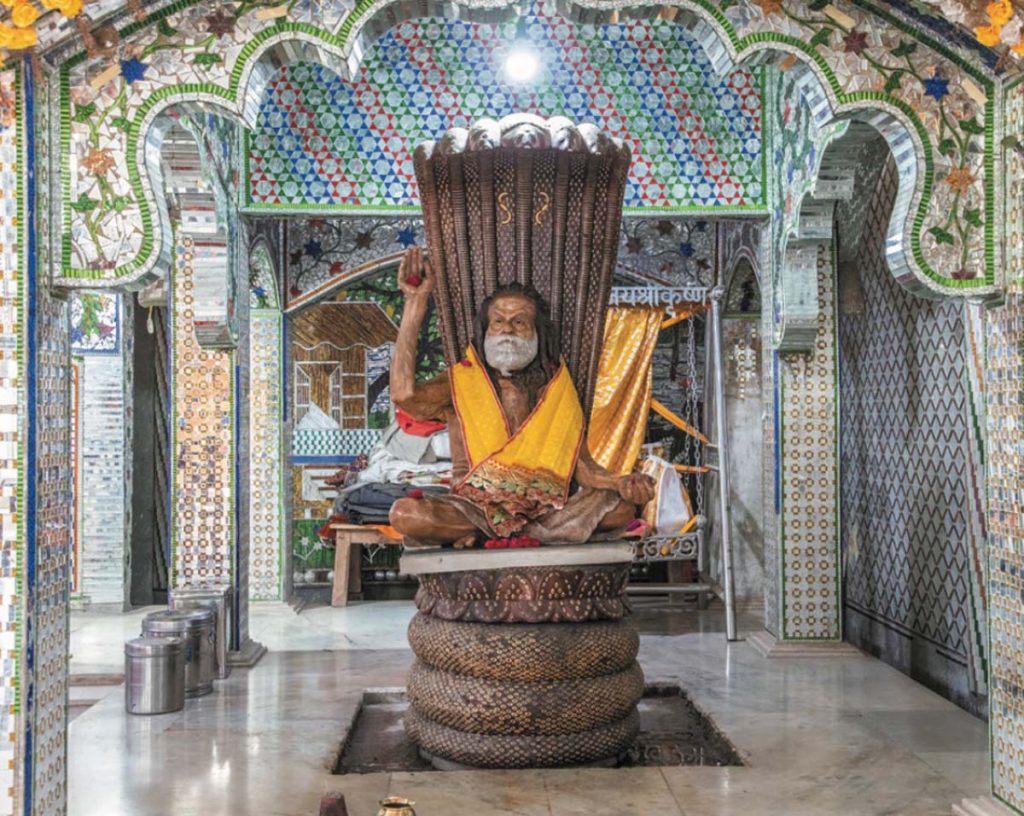
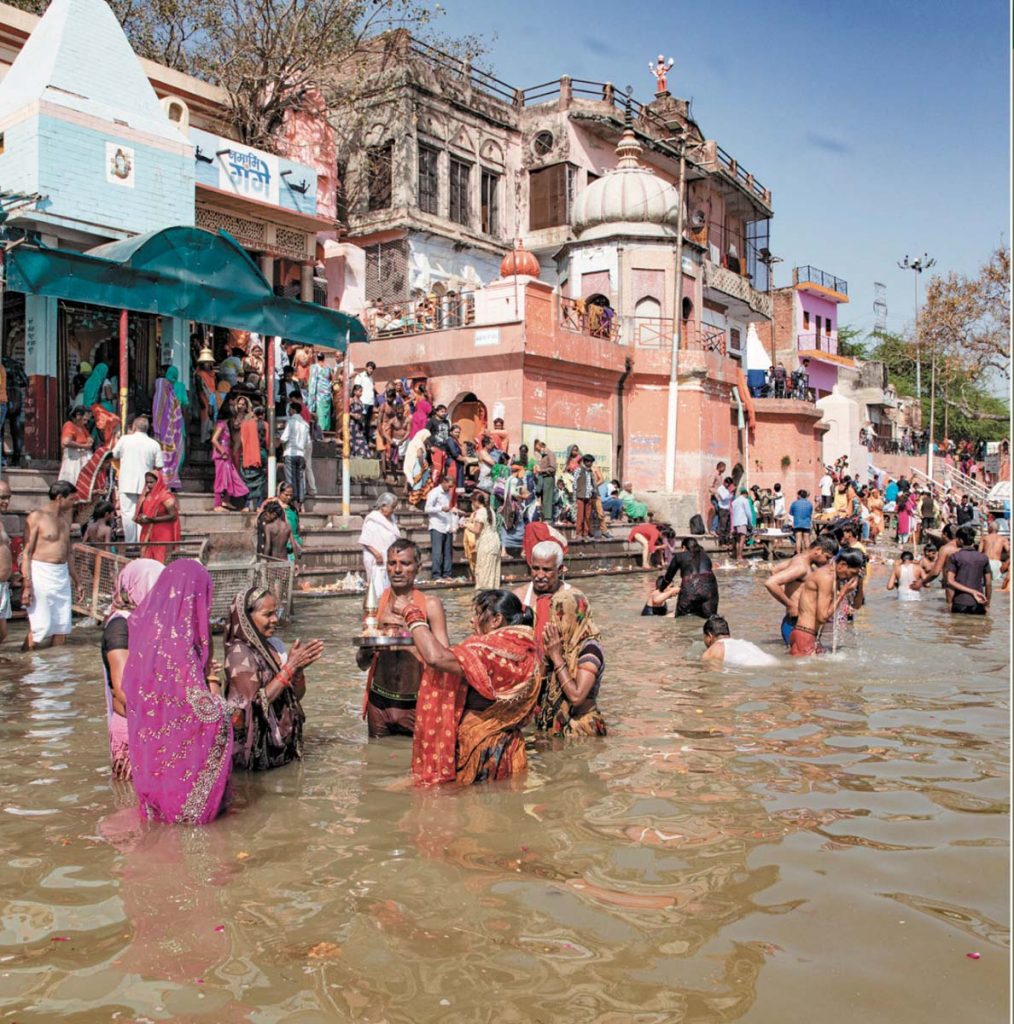
Next I take the opportunity to visit the Deoraha Baba Ashram, just two miles from here. That famous saint passed away in 1990, age unknown. The ashram is situated in a corner of a huge property from which one can glimpse the undulating slopes of the Vindhyachal range. After darshan in the beautiful temple, I am directed to the quarters of Deoraha Baba’s successor, Shree Devraha Hans Baba. After singing in divine ecstasy for about twenty minutes, and then examining the magazine with great interest, he gives me a message for us. “As evident from the articles,” he said in Hindi, “it is a constant effort of Hinduism Today to infuse spiritual ideas in their writings, which will help in awakening of divine consciousness among the readers.”
Continuing my journey home, I stop again in Bithoor for a boat ride along the ghats, and another night stop at Shahjahanpur. I finally return home to Dehra Dun, exhausted, on the 29th.
Conclusion
Winter—preferably February/March—is the best season for a visit to the plains. The various ghats along the river have a lot of color and activity during the new and full moon, so a visit on those days can be quite enjoyable. During Kartik Purnima (November) there are major fairs at Garhmukteshwar and Ramnagaria Mela in Farrukhabad. The grandeur of the old ghats of Vindhyavasini, Bithoor and Karnavas is best absorbed from a boat, which are cheap to hire in the smaller places.
This soul-stirring week has kept me so close to Ma Ganga, much closer than in the big cities She passes through. There is so much more to Ganga than ghats, boats and crowds. It is the rustic charm of Her natural banks, sacred spots where tales of Mahabharata are still so fresh in the minds of devotees. Each temple, ghat and ashram has its own page of history. With my eyes closed, I can relate to all the places and incidents of the great epic, places like Hastinapur, and characters such as Raja Karna, the Pandavas and the Kauravas, strung together so logically and in perfect chronology. I remain awed by the grandeur of temples and ghats constructed by kings and nobles of the past, who drew inspiration from saints and sages visiting these lesser-known corners of the vast Gangetic plains in search of peace and tranquility.

Dev Raj Agarwal of Dehradun, India, is a photographer who loves to capture the immense diversity of people, cultures and nature of India, especially in the Himalayas. He is retired from the Ministry of Environment and Forests, Botanical Survey of India. Email: devrajagarwal@hotmail.com
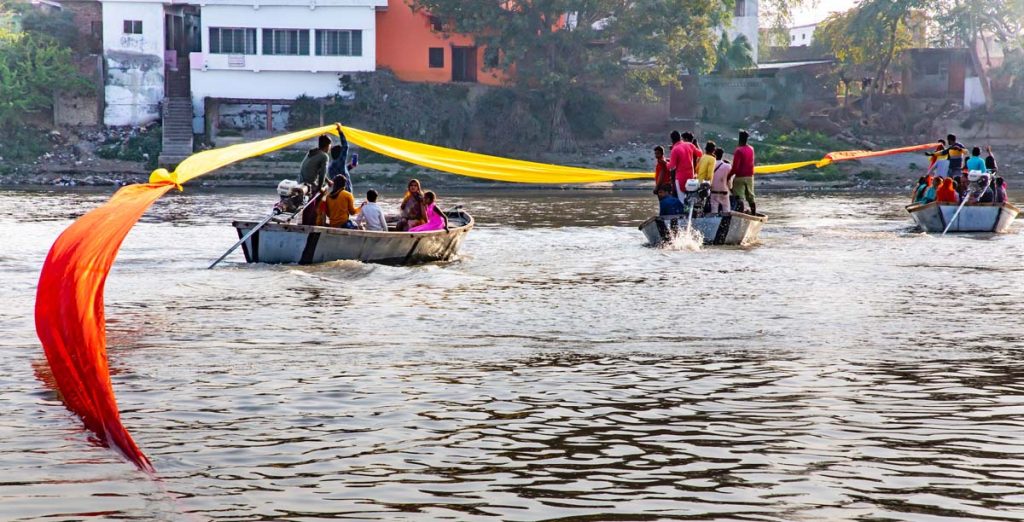
What a wonderful Virtual journey! I love the way you connected it to the Mahabharata, bringing history to life. Thank you for your hard work, especially during a pandemic! Namaste
Dev Raj jee. This is a great account.
I really admire the way you articulate the customs, heritage and cultures survived despite invasions. Each event you spelled has all dimensions, the leisure, entertainment yet the reverence to Ma Ganga as you said. Devotion and honor in the minds of people can be so easily understood the way you’ve described the descried at every place – for example the “Pehran” ceremony, is so romantic yet so respecting.
Thank you very much for this travelogue!